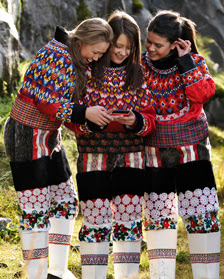Rabu, 03 Juli 2013
Fashion Embroidery
From ancient times, traditional Ukrainian embroidered ornaments вишиванки on clothing have also performed the function of magical talisman - protection for the wearer. It is a symbolic vocabulary - with a power of its own.
Ukrainian embroidery has never been something ordinary, especially because each piece carries the energy of the person who worked and embroidered.
http://ukrainiancalgary.blogspot.com/2012_12_01_archive.html
Posted by: Novelia Meida Kusuma
Swedish Folk Costumes
"uniform Swedish folk costume". The costumes were only worn by the people in the countryside, farmers, their families and servants, and it changed and developed over hundreds of years, and look very different in different parts of Sweden. Some areas have no documented folk costumes at all.
http://amostpeculiarmademoiselle.blogspot.com/2009/10/long-post-on-swedish-folk-costumes.html
Posted by: Novelia Meida Kusuma
Kuchi Dress
The material is soft, breathable, and light weight, perfect for the summer. Comes with matching pants, head scarf, and adjustable belt at the waist.
http://www.zarinas.com/dresses2.shtml
Posted by: Kasih Andaresta
Vietnamese Traditional Clothing
People in Vietnam wear cotton clothes. The Vietnamese typically wear lightweight clothing. Rural women wear loose-fitting dark-pants and blouses that are often embroideredin brilliant colors. Conical nats called non la shield their faces from the sun. In the cities, many girls and women wear the traditional au dai, a long tunic worn with loose-fitting pants. However, a growing number of urban women wear dresses and shirts. Rural and working class men typically wear simple shirts and trousers. City men generally wear Western-style clothing.
http://www.asian-recipe.com/vietnam/vn-information/vietnamese-traditional-clothing.html
Posted by: Novelia Meida kusuma
Posted by: Novelia Meida kusuma
Traditional Russian clothing
Traditional Russian clothing was designed to empathize Russian woman's inner dignity and emotional restraint. Russian costumes are not only beautiful, there are also convenient in wearing because they were created for work without restricting freedom of movement. Festive clothes and everyday clothes, married woman's and young girl's clothes differed only for details, decoration, color gamut. The variety of colors for traditional costume displays love for beauty and ethnic diversity.
http://traditionalclothingoftheworld.blogspot.com/2012/07/traditional-russian-clothing.html
Posted by: Novelia Meida Kusuma
http://traditionalclothingoftheworld.blogspot.com/2012/07/traditional-russian-clothing.html
Posted by: Novelia Meida Kusuma
Hmong Costumes
One of the more fun aspects of Hmong culture are Hmong costumes, although the name "costume" may be misleading. Hmong costumes are really a traditional dress/fashion that is most often worn on special events or during Hmong dances. Hmong culture also allows for the integration of more modern style over time, so many of these costumes have been updated and advanced as time has passed.
http://voices.yahoo.com/4-types-hmong-costumes-8885379.html?cat=16
Posted by: Novelia Meida Kusuma
Traditional Hijab series
Traditional hijab is basically the type of culturally-defined covering worn by Muslim women in their own society or cultural group. For example the Baloochi women of Iran wear a different style of traditional hijab from Bandari Arab women in southern Iran. Basically its just a showcase of these unique and beautiful designs which have developed over hundreds and perhaps thousands of years.
http://www.oldschoolhijabi.com/stores-i-recommend/
Posted by: Novelia Meida kusuma
ABOUT GREENLAND
From traditional dress to national costume
When the Europeans set foot in Greenland in the 17th and 18th centuries, they brought with them clothing fabrics and glass beads as goods to trade. These materials gradually become incorporated into the Inuits' dress, particularly for festive attire. For men the hide trousers were replaced by a thick woollen material called 'holmensklæde' (literally island cloth), and for women the anorak was sewn in silks. The glass beads were initially used in the same way as when decorating oneself with beads fashioned from bone. It gradually became prestigious to use more and more beads, and this trend is particularly visible on the women's national costume.
http://www.greenland.com/en/about-greenland/kultur-sjael/nationaldragter.aspx
Posted by: Novelia Meida Kusuma
Traditional Batik Motif Yogyakarta
Traditional Batik Motif Yogyakarta
Batik patterns are divided into different families of designs, each with hundreds of variations within them. The following gives you a brief introduction to the main design families. You'll see certain designs that belonged to the sacred, forbidden patterns reserved for the royal court. Over time, these particular patterns did enter into common use. Yet to this day, if a person does not belong to the court, they would never wear those patterns inside the keraton, or palace walls.
Ceplok Motifs
http://www.winotosastro.com/batik/batikyogya.html
Posted by: Novelia Meida Kusuma
Kamis, 11 April 2013
Traditional Indonesia Clothing
Kebaya Indonesia is a genuine product. Modern kebaya and traditionally used for weddings. Kebaya period now vary widely, there is a model baju kebaya with Chinese collar, even there is also a similar design kebaya kimono.Kebaya dress wedding adds to the beauty of the moment. No wonder the clothes kebaya idea progressing each year. Wedding moments will always be remembered that the two lovebirds tied the sacred. Beautiful kebaya nan riveting is one element of a wedding that is not only showing the beauty, but also the prestige of the bride.
Posted by: Kasih Andaresta
Traditional India Clothing
SARI
* Traditional Clothing for women is the sari india.
* Sari done rather than the type, style and color of various fabrics.
* Use sari requires a piece of fabric measuring 5-6 ell in length fitted with a colored cloth as if these saris.
* To use this, this will sari wrapped around the body with a portion of the tip that is attached to
embroidered over the left shoulder.
http://prasekolahafzan.blogspot.com/2009/10/pakaian-tradisional-india.html
Posted by: Kasih Andaresta
Traditional Ouchanka (Russia) clothing
Ouchanka (Russia)
Ouchanka is a traditional Russian fur hat and Scandinavia, with hinged sides that can cover the ears and neck, or remain tied to the top of the cap.
http://fenomers.blogspot.com/2012/02/10-pakaian-tradisional-terpopuler-di.html
Posted by: Kasih Andaresta
Ouchanka is a traditional Russian fur hat and Scandinavia, with hinged sides that can cover the ears and neck, or remain tied to the top of the cap.
http://fenomers.blogspot.com/2012/02/10-pakaian-tradisional-terpopuler-di.html
Posted by: Kasih Andaresta
Rabu, 10 April 2013
Traditional Chinese Clothes
No doubt this is one of the traditional dress that has a beautiful concept, selection of motifs and design details and it is wonderful and flexible in use today. If you are generally a traditional outfit that comes from eastern Asia, such as Japan and South Korea with Kimomo with Hanbok using a wide and long clothes, clothing China's premier called the cheongsam is unique because it is so simple usage ramoing and Cheongsam dress will look taller and gracefully because she wears clothes with her slender pasa. Cheongsam dress is characterized by a long piece design has a high neck, short-sleeved, buttoned tight as accompanied by shanghai. Bright colors are usually selected colors especially red.
Posted by: Kasih Andaresta
Rabu, 03 April 2013
Traditional Clothes of Zimbabwe
Zimbabwe Clothing for Women
It is believed that the traditional dresses for the women of the country are decked up with beautiful beads. Large sized ornaments form integral part of the traditional clothing of the women.
Zimbabwe Clothing for Men
The main part of the male attires of Zimbabwe is the breastplate, which is also known as Iporiyana. It is worn around the neck. This is made of animal skin. The animal skin that is used to make Iporiyana differs among tribes. The skin of hyena, and civet is commonly used.
Posted by: Novelia Meida Kusuma
Traditional Mexican Clothing
Puebla
Puebla dresses and blouses generally have short sleeves and loose fits. The Mexican folklore dresses are used by the traditional folk dancers and are very fancy in their overall look. The design of the upper half closely resembles the Puebla blouse. The design of the lower half is also fancy and in many tiers. Mexican clothing was all about comfort and letting the body be at ease with the kind of temperatures faced. This kind of dress is long and flared, and has little puffed sleeves. It became famous as the Boho dress, later on.
Posted by: Novelia Meida Kusuma
Armenian Traditional Clothing
The traditional man's suit consisted of silk or cotton color shirt with low collar and side fastener and wide trousers from dark wool or cotton. Over the shirt Armenians put on cotton or silk arkhaluk – outerwear with low collar fastened waist down with hooks or small buttons. A heavier item was called chukha; it was made of wool and worn with a narrow big buckled belt.
Western Armenians wore a waistcoat over shirt and waist length jacket with full sleeves without fasteners in front. The belt was replaced with long wide woven scarf wrapped around the waist several times.
Women's traditional clothes of both eastern and western Armenians were homogeneous. The outerwear included a long dress of arkhaluk type with a cut on chest and cuts below hips. The waist was wrapped in long folded silk or woolen scarf. The embroidered apron and decorations were indispensable elements for western Armenian women. On their heads men wore caps of different styles: the fur ones were worn in the east; knitted and woven – in the west. Women's headdresses, especially in the east, looked like a "turret" made from cotton fabric with ornaments tied with several scarves covering a part of face. Western Armenian women used to wear ornate head bands with capes.
Posted by: Novelia Meida Kusuma
|
Costa Rica Traditional Clothing
Traditional Clothing for Women Costa Rica
For women in Costa Rica, traditional clothing consists of a dress tailored in a specific style to include a few important characteristics. Firstly the traditional dresses worn by women in Costa Rica on special occasions have thick and flamboyant ruffles protruding upwards and outwards from the shoulders and there are no sleeves to cover the arms. The most popular colors for traditional dresses in Costa Rica are all the bright colors including red, blue and yellow. Often, traditional dress in Costa Rica for women will consist of a long skirt that reaches down to the ankles made from shiny and colorful fabrics. From the waist upwards a plain white top is worn and these two items are brought together by a bright red cloth that is wrapped around the waist similar to a cummerbund. Often, a flower is artistically placed in the ear to top off this beautiful traditional costume for women in Costa Rica.
Traditional Clothing for Men Costa Rica
Traditional clothing for men in Costa Rica is simple yet elegant. Similar to the women, a traditional Costa Rican costume for men consists of a cummerbund, usually red in colour. This is accompanied by plain colored shirt and pants usually both white in color although this can vary. In addition a traditional Costa Rican costume for men will also include a straw cowboy type hat as well as a red scarf that is tied around the neck.
On a day to day basis, regular clothing in Costa Rica is more or less the same as you would find in America, consists of t-shirts and pants. One interesting point about clothing in Costa Rica is that despite the warm weather and tropical climate, men rarely walk around wearing shorts but prefer to wear pants. Costa Ricans tend to only wear shorts when going to the beach, although that doesn’t mean you should feel uncomfortable wearing shorts while in Costa Rica.
Posted by: Kasih Andaresta
Traditional Russian clothing
Traditional Russian clothing was designed to empathize Russian woman's inner dignity and emotional restraint. Russian costumes are not only beautiful, there are also convenient in wearing because they were created for work without restricting freedom of movement. Festive clothes and everyday clothes, married woman's and young girl's clothes differed only for details, decoration, color gamut. The variety of colors for traditional costume displays love for beauty and ethnic diversity. Red fabric cloth was considered to be the nattiest one.
Posted by: Novelia Meida Kusuma
Selasa, 02 April 2013
Pakistan's Traditional Clothing
Men also prefer Sherwani and vest along with the salwar kameez. Kandahari or Jinnah cap is also commonly paired with a Sherwani or a salwar kameez. A Sherwani is a long coat worn with a salwar and is generally made from heavy fabrics. Peshawari Chappals and Khussa are the most preferred footwear among men. In regions where temperature is considerably cold, men opt for Pashmina or Shahtoosh shawls to keep them warm.
Salwar kameez and lehenga are the traditional attire worn by women in Pakistan. While salwar kameez is also worn as a daily wear, lehenga is a typical attire for ceremonies and special occasions. Interesting patterns woven with lace are used to add feminine element to the lehenga. Women also wear a dupatta with both salwar kameez and lehenga. Dupattas are long yards of cloth; their colors and patterns are coordinated as per the entire ensemble. Women also wear scarves or shawls with the salwar kameez in the chilly winters.
Posted By: Novelia Meida Kusuma
Traditional African Clothing
Clothing for Men
The traditional African shirt worn by men is known as "Danshiki" or "Dashiki". This traditional shirt is very long, ending a few inches above the knees. Its sleeves are elbow length. There are a variety of pattern and designs on these shirts, especially near the base of the shirt and also around the neck. Danshikis are usually paired with traditional men's pants, also known as "Sokoto". Even today Danshikis have not lost their charm and are worn by men with pants or jeans. Traditional men's clothing will be incomplete without the mention of "fila", which is the traditional cap worn by men in Africa. Like the scarf which the African women support, fila is an accessory, without which the traditional African men's wear is considered incomplete.
Clothing for Women
Clothing for women mainly constitutes a variety of "Kaftans", which come in different styles, prints and colors. The free-flowing kaftan is the dressing style of the commoners, while a well-fitted kaftan is worn by the African royalty, queens and women belonging to prominent families. The colors of the kaftans vary greatly, with women opting anything, right from the light earthy tones to the vibrant, striking colors such as red and violet. The prints are usually very large and consist of traditional tribal designs and symbols. Ancient Africans used a variety of tie and dye designs too on their clothes. Indigo plant was mainly used for dyeing the traditional African clothes.
http://www.buzzle.com/articles/traditional-african-clothing.html
Posted by: Kasih Andaresta
The traditional African shirt worn by men is known as "Danshiki" or "Dashiki". This traditional shirt is very long, ending a few inches above the knees. Its sleeves are elbow length. There are a variety of pattern and designs on these shirts, especially near the base of the shirt and also around the neck. Danshikis are usually paired with traditional men's pants, also known as "Sokoto". Even today Danshikis have not lost their charm and are worn by men with pants or jeans. Traditional men's clothing will be incomplete without the mention of "fila", which is the traditional cap worn by men in Africa. Like the scarf which the African women support, fila is an accessory, without which the traditional African men's wear is considered incomplete.
Clothing for Women
Clothing for women mainly constitutes a variety of "Kaftans", which come in different styles, prints and colors. The free-flowing kaftan is the dressing style of the commoners, while a well-fitted kaftan is worn by the African royalty, queens and women belonging to prominent families. The colors of the kaftans vary greatly, with women opting anything, right from the light earthy tones to the vibrant, striking colors such as red and violet. The prints are usually very large and consist of traditional tribal designs and symbols. Ancient Africans used a variety of tie and dye designs too on their clothes. Indigo plant was mainly used for dyeing the traditional African clothes.
http://www.buzzle.com/articles/traditional-african-clothing.html
Posted by: Kasih Andaresta
Minggu, 31 Maret 2013
Traditional German Clothing
The dirndl was the uniform of the Austrian servants. Traditionally,
every village even had its own particular style of this dress, in
accordance with the concept of tracht. The dirndl comprises many
garments that make up the entire outfit. It was made up of a fitted
bodice which was worn with a blouse, a full skirt, petticoat, and an
apron. The blouse was generally made of either cotton or lace. Some
women chose to wear the outfit without a blouse. The apron was more
often than not of a contrasting color. For festive occasions, the dirndl
was often accentuated with embroidery, elaborate hats, and accessories
like lace, ribbons, trims, etc., that were plaited.
The word lederhosen translates to leather pants in German. These are knee breeches, and were worn by the Germanic men of the Alpine areas and the surrounding locales. The pants were made of leather. This traditional style was also worn by young boys. Lederhosens worn in the Bavarian region had features such as suspenders and front flaps, and these were quickly adopted by other countries. These pants were worn with shirts and sweaters made of coarse linen or wool. Other clothes teamed with the pants were wool stockings and country shoes. Jackets and hats were worn by some men.
Rabu, 06 Maret 2013
Traditional Clothing of the World
Sri Lanka
The traditional clothing of Sri Lanka is very interesting. Women (near the age of marrying or already married) normally wear a sari, also known as Kandyan Sari as traditional clothing.

Sinhalese girls wear half saree, a cloth and jacket with a frill around shoulders. Tamil little girls wear pavadai sattai, which is pretty much a skirt with a design and a blouse. The aged Tamil girls (who have reached puberty) normally wear half sarre's which is like a saree but not fully, there would be a long scarf or cloth to put on your left shoulder and gets tucked in your skirt and it is like a pavadai sattai too!
 Sinhalese
men wear Sarong and shirt called Baniyama. And Tamil men wear patta
vetty which is a shirt and a long cloth which they wrap around their
waist.
Sinhalese
men wear Sarong and shirt called Baniyama. And Tamil men wear patta
vetty which is a shirt and a long cloth which they wrap around their
waist.
The Kandyan Saree is prepared with a long piece of Clothing of about 7 yards or more. The material of this is usually pure cotton, which is comfortable to wear since sri lanka has quite a hot climate. The picture shown on the side is of a kandyan saree which is mostly worn by the women of hill country in sri lanka.
the southern wealthy women wear the kandyan saree in a different style. But now a days many of the southern women wear the saree in the Indian style.
 An
indication of the caste system in Sri Lanka, this dress can be worn by a
particular section of the society. There are many customs and
observances that have to be carried out when making this dress as well
as in dressing it.
The
whole costume consists of many parts. They are the reli kalisama, the
viluda papu patiya, the sudu thippotiya, pachcha wadama, Somana,
Kavaniya, the velvet jacket, thoppiya with the mal gaha, the knife, the
shoes, Peras mudda, and the necklace with the medal.
An
indication of the caste system in Sri Lanka, this dress can be worn by a
particular section of the society. There are many customs and
observances that have to be carried out when making this dress as well
as in dressing it.
The
whole costume consists of many parts. They are the reli kalisama, the
viluda papu patiya, the sudu thippotiya, pachcha wadama, Somana,
Kavaniya, the velvet jacket, thoppiya with the mal gaha, the knife, the
shoes, Peras mudda, and the necklace with the medal.
The traditional clothing of Sri Lanka is very interesting. Women (near the age of marrying or already married) normally wear a sari, also known as Kandyan Sari as traditional clothing.
Sinhalese girls wear half saree, a cloth and jacket with a frill around shoulders. Tamil little girls wear pavadai sattai, which is pretty much a skirt with a design and a blouse. The aged Tamil girls (who have reached puberty) normally wear half sarre's which is like a saree but not fully, there would be a long scarf or cloth to put on your left shoulder and gets tucked in your skirt and it is like a pavadai sattai too!
The Kandyan Saree is prepared with a long piece of Clothing of about 7 yards or more. The material of this is usually pure cotton, which is comfortable to wear since sri lanka has quite a hot climate. The picture shown on the side is of a kandyan saree which is mostly worn by the women of hill country in sri lanka.
the southern wealthy women wear the kandyan saree in a different style. But now a days many of the southern women wear the saree in the Indian style.
Traditional costume of Sri Lanka "Udarata Mul Anduma’
The
‘Udarata Mul Anduma’ is a very important as well as impressive form of
dress. It is popular among not only kandyans as well as other Sinhalese
during their marriage and other important events. A velvet jacket, four
separated cloths, a carved knife, and four corner elaborated head gear
make the wearer fell like a knight of yore. But many fail to realize its
significance today.
‘Mul
Anduma’ has an Indian origin, believed to have been introduced to Sri
Lanka during Nanayakkar dynasty. This form of dress evolved into the
standard regalia of royal officials. It is later continued to worn by
Rate Mahattaya, Mohottala, Dissawa, and the Basnayaka Nilame.
The original ‘Mul Anduma’ comprised seven items to be worn around the waist. It has now come down to four. An
indication of the caste system in Sri Lanka, this dress can be worn by a
particular section of the society. There are many customs and
observances that have to be carried out when making this dress as well
as in dressing it.
An
indication of the caste system in Sri Lanka, this dress can be worn by a
particular section of the society. There are many customs and
observances that have to be carried out when making this dress as well
as in dressing it.13 Traditional Costumes from Around the World
So what on earth, you say, am I doing writing about traditional
clothing on a science blog? Apart from the fact that it’s interesting
and fun to look at? Partly it’s because I have a background in the
‘softer’ sciences, such as anthropology and archaeology. They don’t have
laboratory experiments, but they can still be studied in a scientific
way. But also, clothes are something that even little kids are familiar
with, and they can start to make links between clothes and where people
live or do comparisons.
For example, if you compare
For example, if you compare
-
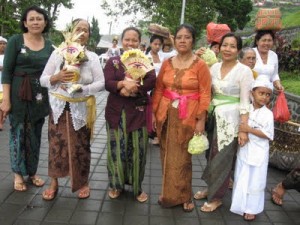
Balinese -
Bali and the Caribbean are far apart, but they are both tropical islands and developed relatively similar clothes to help cope with the weather.
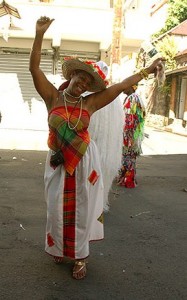
Caribbean -
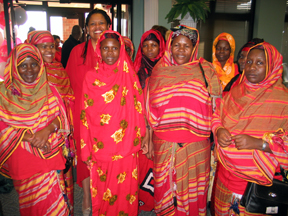
Sudanese -
Especially if you then add in these very hot countries.

Sari from India -
Historically, both India and Mongolia were part of the Silk Road, which can be seen in the materials they use. And the Mongolian clothing is extremely practical for a nomadic lifestyle, where everything needs to be carried and a blizzard may blow up out of nowhere.

Mongolian -

Swedish -
Both Sweden and Peru are significantly colder, plus the materials used in Peruvian clothing are unique – llama wool.

Peru -

Greece -
Ethiopia is hot but cooler than other parts of Africa because of its plateau. And it has historical ties with both Africa and the Mediterranean.

Ethiopia -
And then there are the whole range of clothes that aren’t made from woven cloth but local materials such as leather,
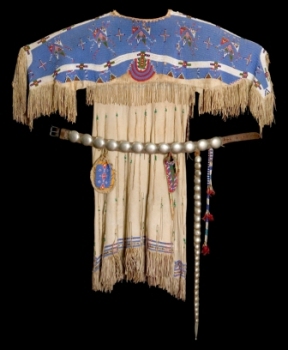
Lakota -
fur,
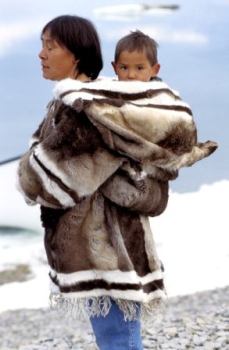
Inuit -
or at the other end of the climate scale, leaves, bones and feathers. (Did you know the semi-official name of one of the traditional New Guinean costumes is arse-grass?)
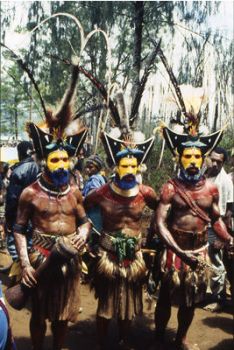
Papua New Guinea -
And here we have one of my favourites, the Torres Strait Islands. The reason I like these is because they are a brilliant demonstration that culture is not static, but dynamic and living. Part of their traditional costume is a grass skirt, and in the past these were your standard pale yellow. But the colours used in their flag are symbolic – blue for the sea, green for the land, white for peace and black for the people. And it just so happens that plastic shopping bags come in these colours. I’ve seen Torres Strait Islander people dancing in skirts that are made from plastic strips rather than grass, which isn’t somehow a step backwards, but shows how they can incorporate their traditions while taking advantage of the modern world.
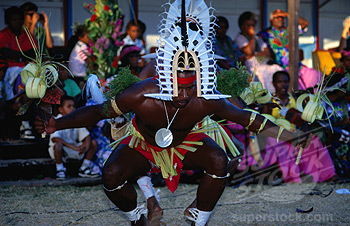
Torres Strait Islands
http://science-at-home.org/13-traditional-costumes-from-around-the-world/
Langganan:
Postingan (Atom)






